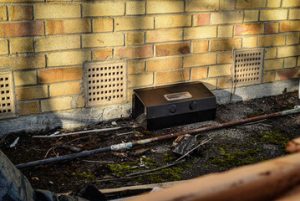Mice are sneaky, nocturnal pests that can contaminate food and cause structural damage. Your local Rodent Retreat control specialist can help prevent infestations by recommending cleaning strategies and rodent-proofing tactics.
In addition to sealing any gaps, cracks, or holes larger than a mouse’s skull, your exterminator can also recommend decluttering areas that mice like to hide in. This includes removing cluttered or overgrown vegetation.

Food and Water Sources
Rodents seek out warmth and shelter in the winter, often finding their way into homes in search of food and water. These critters can cause damage and spread disease, as well as trigger allergies and asthma in humans due to proteins in their urine, droppings, and saliva. They also gnaw through electrical wires and wood, creating fire hazards.
Scratching or squeaking noises in the walls or ceilings at night are a clear indication of a rodent problem. You might also see gnaw marks on furniture, appliances, or walls. Droppings are usually small, soft, and dark in color when fresh. A smudge on your window is another indication that mice are nearby.
Mice can squeeze through surprisingly small openings, so it is important to keep your home clean and clear of clutter that could serve as a nesting spot. Use plastic boxes with tight-fitting lids to store paper items and keep food in sealed containers. Keep pet food bowls elevated off the floor and empty the trash frequently to eliminate potential food sources.
A professional wildlife specialist will conduct a thorough inspection to assess the extent of the rodent problem and determine the necessary steps to eliminate it. Your pest control expert will look for specific signs, including gnaw marks, droppings, smudges, and possible places where rodents are entering your home. Exterior entry points will be sealed with a product that is designed to prevent pests from entering homes through cracks and crevices.
Nesting Sites
As mice search for warm living areas in the fall and winter, they often choose homes as nesting sites. Mice can build nests out of almost anything, including paper, string, and grass. The appearance of mouse droppings in a home is a sign that it’s time for a pest control inspection. Droppings are typically 1/4″ or less in length and soft to the touch. You might also notice gnaw marks on food packaging, furniture, and other items around the house.
Rodents like to chew on electrical wires and can cause fire hazards by gnawing through insulation, causing dangerous sparks. This gnawing may also lead to costly repair bills or even electrical outages. An experienced pest professional will identify signs of rodent damage and take steps to prevent re-infestation.
Your technician will conduct a property inspection to find the source of your rodent problem. They will look for any cracks, crevices, gaps, or openings that are large enough for mice to enter. They will also look for outdoor debris or clutter that can provide hiding spots or food sources for rodents. Your technician can then use our advanced exclusion methods, such as our exclusive products or other pest-proofing solutions, to seal the entry points and prevent future problems. They can also install exterior rodent stations to monitor and bait for rodent activity.
Entry Points
Rodents can enter homes seeking food, water, shelter, and warmth. They contaminate food and surfaces with their feces, urine, and shed hairs; spread diseases like salmonella and hantavirus; and cause damage to property by chewing wires and wood. Mice also aggravate allergies and asthma. A professional pest control technician can help prevent rodent invasions by identifying and sealing entry points.
Dark corners and crevices often conceal mice entry points. A flashlight pointed in these areas highlights droppings, shredded paper, and tiny holes mice use to sneak inside your walls. Scratching noises and musky odors may also signal rodent activity.
Entry points can be found near the exterior of your home, basements, and crawl spaces. Ill-fitting doors and windows, worn seals, and cracks in foundation walls invite rodents in. Check your foundation regularly and fill small gaps with caulk or concrete.
Outside your home, look for rodent-sized holes around the chimney and roofline. Remove piles of firewood or debris that provide hiding spots for rodents. Keep the grass trimmed and debris away from the house, as well.
Mice can squeeze through openings the size of a dime, so it is important to inspect your property regularly for these tiny vulnerabilities. Fortifying your home with rodent exclusion services, including installing door sweeps and replacing torn window and vent screens, can help prevent infestations.
Damage
Mice are destructive both inside and outside your home. They can ruin food in cabinets, chew holes in wires, and cause fires by gnawing through electrical insulation. They also spread diseases through their urine and feces. Even if you have a minor infestation, it can become out of control quickly as mice reproduce rapidly.
While you can take some steps on your own to prevent mice, full protection requires professional help. You need to identify signs of mouse activity like droppings, gnawing, and rub marks, as well as sounds from scratching in walls or ceilings at night. You should also check for smudges and greasy spots on your walls, floor, or appliances. Additionally, you should trim overgrown trees and shrubs near your house to make it difficult for rodents to bridge over to your property.
A professional pest control company will conduct a property inspection to assess the scale of your problem and identify entry points, nesting sites, and potential damage. Then they can implement targeted prevention measures to stop rodents from invading your home. This includes ground-level exclusion by sealing cracks, gaps, and voids around your doors and windows using caulk or steel wool. In addition, the technician can set traps and bait stations in high-activity areas to eliminate mice before they cause any serious damage.